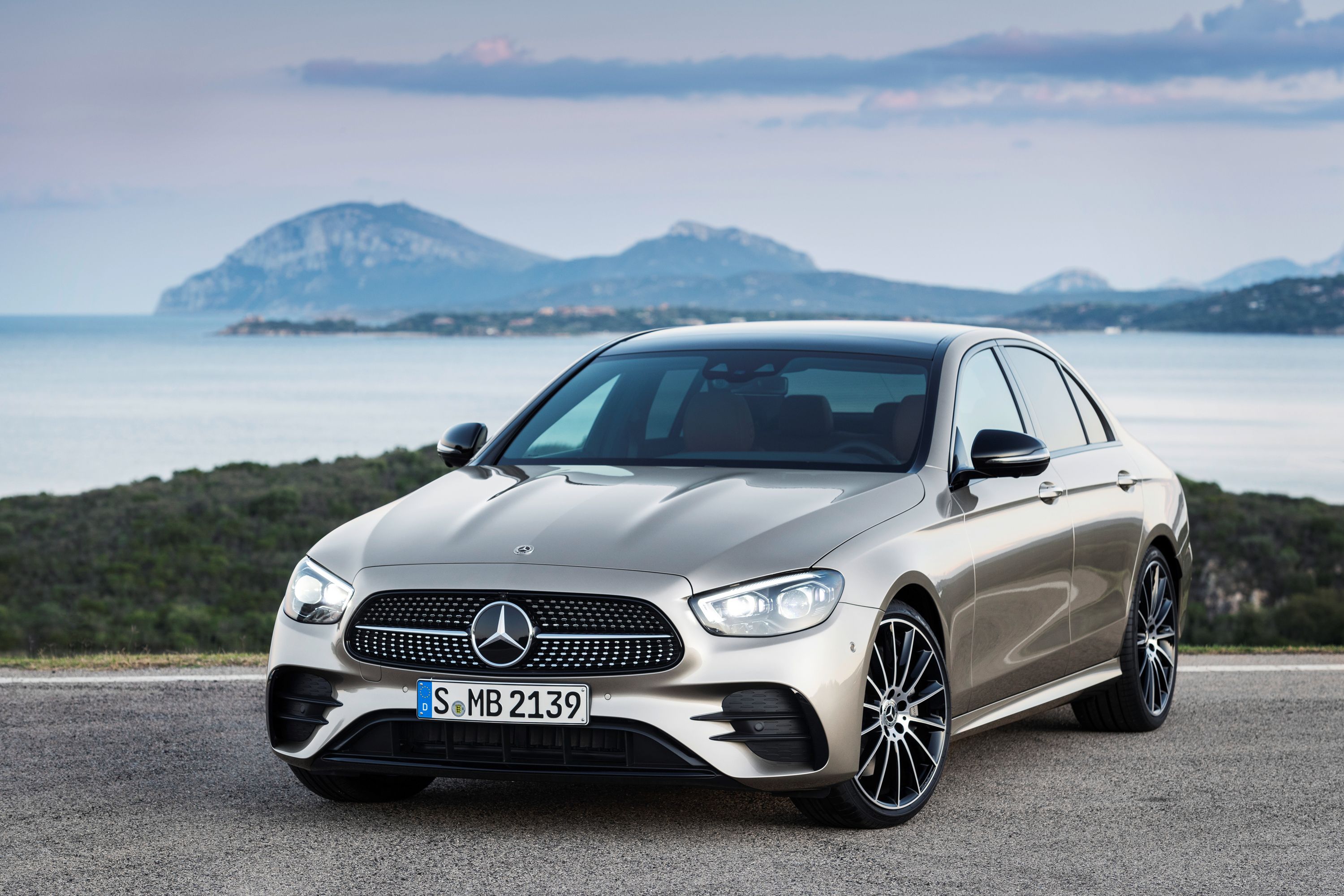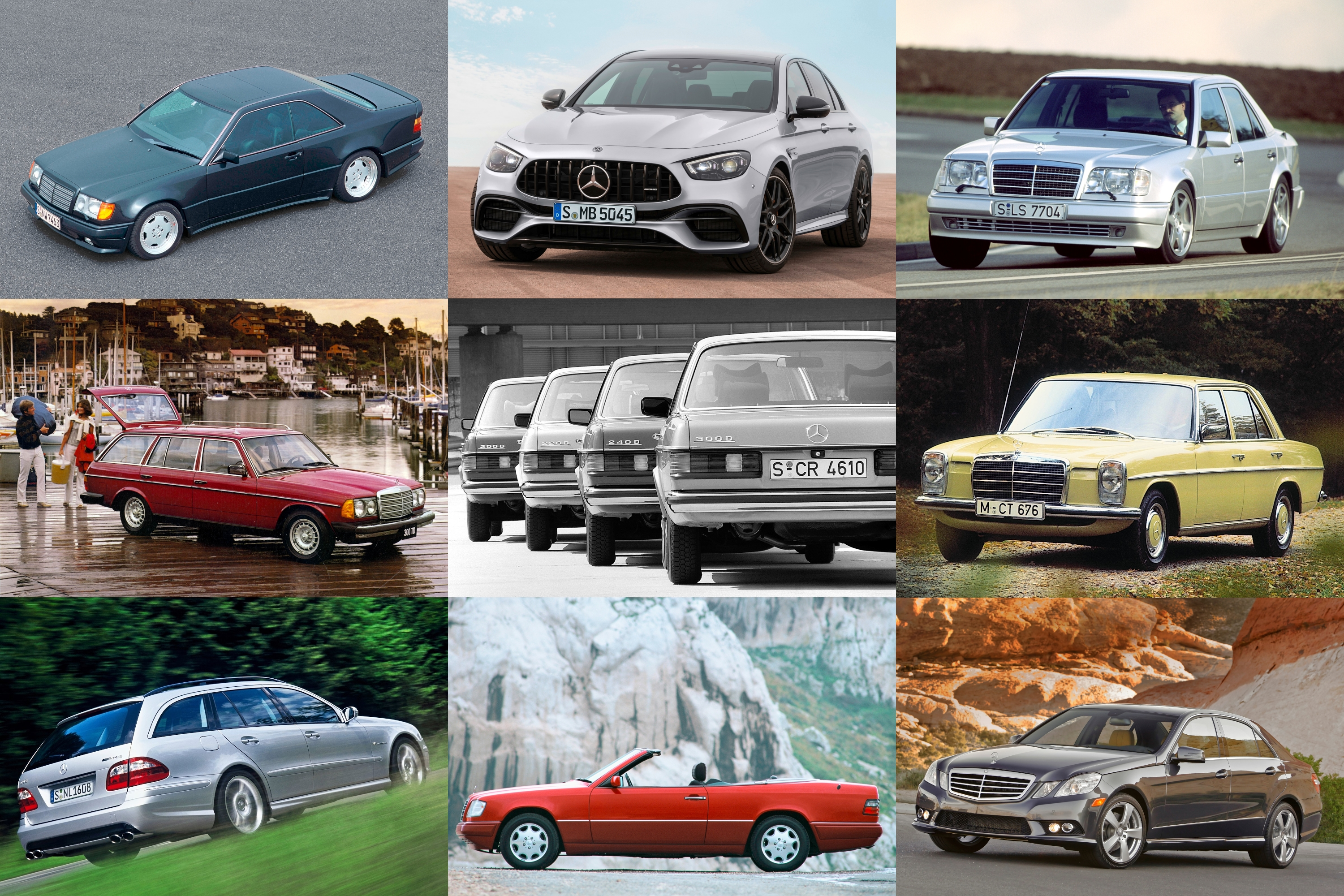
At first glance, the Mercedes-Benz E-Class is a regular executive car: the sort of thing you'd see cruising around the world's financial districts. In some regions, the E-Class nameplate is synonymous with airport taxis. But it's more than just a sedan. It's an icon, a wheeled symbol of durability, innovation, build integrity, and, sometimes, incredible performance.
While SUVs are now the preferred choice of propulsion for motorists, there was a time when the E-Class range was the backbone of the Mercedes lineup, serving as the stern and sensible luxury car for those with exacting standards. An all-new generation E-Class has made its debut in the form of the W214, meaning it's a great time to look back at the family history. But instead of just chronicling every generation, we decided to pick out 10 iconic models from its history celebrating the good and the bad that led us to where we are today.
1. Mercedes-Benz 280E (W114)
Although it's technically not an E-Class, the W114/5 series is a predecessor of the E-Class lineage we know today. First introduced in 1968, the "New Generation" midsize sedan was one of the most modern and sophisticated Mercedes-Benz vehicles available at the time.
Designed by Paul Bracq (who also penned the gorgeous SL Pagoda), the W114/5 debuted with fresh styling and a new suspension system. It was the first post-war Mercedes production vehicle to use an all-new setup; the ball-joint front and semi-trailing arm rear suspension was impressive at the time and would be used until the multi-link rear suspension debuted on the W201 190 series.
Perhaps the most desirable model is the W114 280, which employed a 2.8-liter straight-six that produced a lusty (for the time) 185 horsepower and 175 lb-ft of torque. Initially, "E" denoted a vehicle with fuel injection (Einspritzung) but later came to represent the mid-sized Mercedes sedan. The W114/5 is a safety pioneer, with inertia reel seat belts and a padded steering wheel introduced with the facelifted model.
2. Mercedes-Benz 300D (W123)
If you're looking for a car that will survive the apocalypse, look no further than the W123. Produced between 1976 and 1986, the Mercedes W123 is one of the toughest cars in the world. Known to endure millions of miles and plenty of mistreatment, the stately executive sedan is considered by many to be the best Mercedes ever built.
A variety of engines were made available and, while all of them are seemingly unburstable, the diesel derivatives are the most durable of them all. In the United States, the most common iteration of the W123 is the 300D Turbodiesel. With 119 hp and 170 lb-ft, progress is best described as glacial (0 to 60 mph takes 14 seconds on a good day), but strong performance was never what the W123 was about.
Mercedes designed it to charge down the highway with authority, protect its occupants in a crash, and venture into the desert without fear of breaking down. Despite a high price tag when new, Mercedes-Benz shifted a staggering 2.7 million units in 10 years, which is a testament to the sheer desirability of the W123.
3. Mercedes Benz S123
The W123 series also spawned the first factory-sanctioned station wagon from Mercedes-Benz, known as the S123. Designated the T-Model (T stands for Touring and Transport), the S123 was instantly snapped up by well-to-do families that required an upmarket and practical wagon.
Production kicked off in 1978 and formed part of a range that included a sedan, limousine, and coupe. Nearly 50 years since its introduction, the S123 wagon is considered one of the most collectible 123-series vehicles money can buy, owing to its status as a usable classic.
Like its sedan sibling, the S123 was designed to be incredibly safe in an accident. Large crumple zones absorbed more energy, channeling crash energy away from the safety cell. Furthermore, in a crash, the steering column was designed to buckle in different directions, reducing the risk of the column intruding within the cabin.
4. Mercedes-Benz 300E (W124)
First revealed in 1986, the W124 was a drastic departure from its predecessor. The angular, upright bodywork, almost entirely devoid of chrome, previewed the new direction of Mercedes' design language. At the time, the W124 was the most aerodynamic vehicle in the world, with a wind-cheating Cd figure of 0.29.
It was also the sportiest midsize Mercedes sedan ever, particularly the "300" derivative. With a silky-smooth 3.0-liter straight-six under the hood, the range-topper debuted with 185 hp and 192 lb-ft. That may not sound like much now, but it was enough to impress critics back in the day, who lauded the W124 for its superb handling. These surprising dynamic capabilities came courtesy of the advanced multi-link rear suspension, which Mercedes still uses to this day.
Like its predecessors, the W124 was a trailblazer. The retractable rear headrests were an inspired idea, and so too was the "monoblade" windscreen wiper that cleared 86% of the screen with one wipe.
In 1993, a second facelift arrived, and the midsized W124 would officially become known as the E-Class.
5. Mercedes-Benz A124/C124
Like its predecessors, the W124 E-Class would spawn a sleek coupe. But, for the first time ever, a soft-top convertible would appear too. The coupe hit the scene in the late '90s and combined the angular styling of the W124 with a sleek roofline and pillarless windows.
It was a hit with well-off customers who craved the luxury and solidity of the sedan in an elegant coupe shape. Several powerplants were available, but the 300 and 320 straight-six engines were most desirable. The two-door also spawned the legendary "Hammer," a pre-merger AMG that has become a legend in automotive circles. With a mighty V8 borrowed from the 560 SEL/SEC, the engine was enlarged to 6.0 liters. With 385 hp and 417 lb-ft, it could keep up with contemporary supercars but still cruise down the highway with comfort.
The convertible was introduced in the early '90s and was the first four-seater convertible from Mercedes in nearly 20 years. These vehicles exchange hands for hefty amounts, owing to their relative rarity. Both models were replaced by the CLK, with the E Coupe and Cabriolet only coming back in the 2010s.
6. Mercedes-Benz 500E/E500
Perhaps the most legendary iteration of the W124, the 500E was born out of Mercedes' desire to beat its fiercest rival at its own game. The BMW M5 was the ultimate performance sedan at the time, and Stuttgart wanted to topple it with a V8-powered riposte.
But there were a few issues. Mercedes engineers were preoccupied with the development of the W140 S-Class, so the automaker had no manpower to develop a sports sedan. Instead, it contacted Porsche to engineer a legendary performance sedan based on the W124.
Powered by the 322 hp M119 5.0-liter from the then-new SL, Porsche was tasked with figuring out how to fit the V8 in the relatively compact W124. In the end, the sports car maker was successful and even helped build the 500E. A complicated production process meant the M5 rival took a staggering 18 days to build.
Aside from the pronounced wheel arches, the 500E/E500 was as understated as the car on which it was based. The only signs that it was something special came courtesy of the rear badging and the V8 exhaust note. With just 10,479 examples produced, it's a truly special E-Class and, perhaps, the most iconic of them all.
7. Mercedes-Benz W210
"What's this doing here?" I hear you ask. Yes, the W210 wasn't the E-Class's finest hour. Quality issues, rust-prone bodywork, and less-than-perfect electrics have given the "bug-eyed" Benz a rather poor reputation. It followed the flawless W124 and failed to fill the shoes left by its predecessor. But it did usher in a unique styling trait that would be adopted by many more E-Class models.
The signature quad-headlight front fascia drew plenty of criticism when introduced, and detractors attacked the styling, calling it "ungainly," "bulbous," and downright ugly. Nearly 30 years later, the W210 has amassed a loyal following, who understand the left-field Mercedes. With proper care and maintenance, they will last forever and provide champagne thrills on a beer budget.
V8-powered E430 and E55 AMG models are the most desirable of them all, along with the cavernous wagon.
8. Mercedes-Benz E55 AMG (W211)
Despite its best efforts with the 500E and subsequent E55, Mercedes hadn't succeeded in besting BMW in the high-performance sedan segment. When the E39 M5 arrived in 1999, the Munich-based brand had effectively rewritten the sports sedan rulebook. It rendered the W210 E55 obsolete, and Mercedes was forced to return to the drawing board.
Years later, the E55 AMG (W211) would hit the scene and blow the BMW away with a supercharged "M113K" 5.4-liter V8 that produced 469 hp and 516 lb-ft. That's impressive by today's standards, so it was unthinkable that Mercedes would shoehorn such a monstrous engine into its respectable executive sedan.
At the time it was revealed, the E55 AMG was the fastest production sedan in the world. 0 to 60 mph was dealt with in just 4.5 seconds, and without a limiter, the AMG could nudge 180 mph. It's in-gear acceleration was even more visceral, and road tests of the era saw it leave the M5 and RS6 for dead on rolling runs.
9. Mercedes-Benz E-Class (W212)
The W212 is another respectable but pedestrian luxury sedan. Following the troubled W210 and W211 series, this generation of E-Class saw Mercedes emphasize build quality again. A beautifully finished cabin combined high-class finishes with plenty of electronic gadgetry, making the W212 an impressive car for its time.
But that's not why it's here. This wheeled technocrat earns a spot on this list because it was a safety pioneer. Attention Assist was first seen on this model, along with adaptive high-beam assist. Other safety features included automatic emergency braking and blind-spot monitoring. While this technology is now available on just about every new car, it was the stuff of science fiction more than a decade ago.
Of course, performance junkies remember the W212 for the incredible E63 AMG, which used either a 6.2 or 5.5-liter V8, depending on the model year.
10. Mercedes-AMG E63 S (W213)
Arguably one of the most menacingly styled Mercedes sedans, the E63 is widely acknowledged to be one of the finest cars ever to leave Affalterbach. The fiery AMG has garnered praise from across the world. Thanks to a potent V8 packing a 603-horsepower punch, this was one E-Class that wasn't destined to cruise to the country club and back.
But it's about so much more than performance. With widespread electrification fast approaching, the E63 represents the end of era. The new AMG E-Class will abandon the legendary V8 configuration in favor of a more sensible hybridized inline-six.
While it's inevitable, it's sad to see the E-Class AMG as we know it disappear. The W213 E63 represented everything that was right with Mercedes, thanks to a superb blend of performance and luxury. It was the ultimate sleeper and a true alternative to the BMW M5.
The E63 S will go down as a legend and, one day, when the electric car is king, we will look back and fondly remember the spine-tingling burble of the turbocharged 4.0-liter V8.

